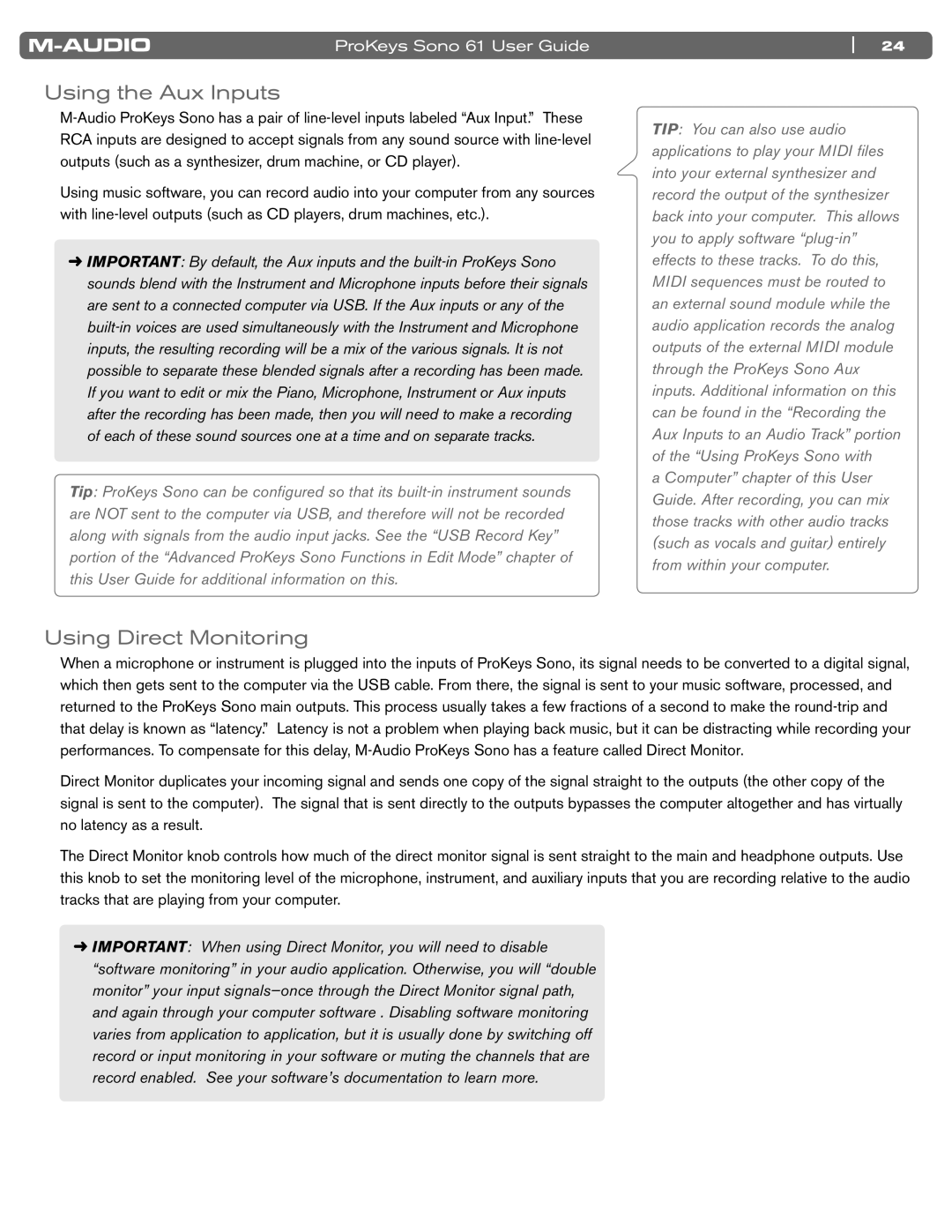
ProKeys Sono 61 User Guide
Using the Aux Inputs
M-Audio ProKeys Sono has a pair of line-level inputs labeled “Aux Input..” These RCA inputs are designed to accept signals from any sound source with line-level outputs (such as a synthesizer, drum machine, or CD player)..
Using music software, you can record audio into your computer from any sources with line-level outputs (such as CD players, drum machines, etc..)..
➜IMPORTANT: By default, the Aux inputs and the built-in ProKeys Sono sounds blend with the Instrument and Microphone inputs before their signals are sent to a connected computer via USB. If the Aux inputs or any of the built-in voices are used simultaneously with the Instrument and Microphone inputs, the resulting recording will be a mix of the various signals. It is not possible to separate these blended signals after a recording has been made. If you want to edit or mix the Piano, Microphone, Instrument or Aux inputs after the recording has been made, then you will need to make a recording of each of these sound sources one at a time and on separate tracks.
Tip: ProKeys Sono can be configured so that its built-in instrument sounds are NOT sent to the computer via USB, and therefore will not be recorded along with signals from the audio input jacks. See the “USB Record Key” portion of the “Advanced ProKeys Sono Functions in Edit Mode” chapter of this User Guide for additional information on this.
24
TIP: You can also use audio applications to play your MIDI files into your external synthesizer and record the output of the synthesizer back into your computer. This allows you to apply software “plug-in” effects to these tracks. To do this, MIDI sequences must be routed to an external sound module while the audio application records the analog outputs of the external MIDI module through the ProKeys Sono Aux inputs. Additional information on this can be found in the “Recording the Aux Inputs to an Audio Track” portion of the “Using ProKeys Sono with
a Computer” chapter of this User Guide. After recording, you can mix those tracks with other audio tracks (such as vocals and guitar) entirely from within your computer.
Using Direct Monitoring
When a microphone or instrument is plugged into the inputs of ProKeys Sono, its signal needs to be converted to a digital signal, which then gets sent to the computer via the USB cable.. From there, the signal is sent to your music software, processed, and returned to the ProKeys Sono main outputs.. This process usually takes a few fractions of a second to make the round-trip and that delay is known as “latency..” Latency is not a problem when playing back music, but it can be distracting while recording your performances.. To compensate for this delay, M-Audio ProKeys Sono has a feature called Direct Monitor..
Direct Monitor duplicates your incoming signal and sends one copy of the signal straight to the outputs (the other copy of the signal is sent to the computer).. The signal that is sent directly to the outputs bypasses the computer altogether and has virtually no latency as a result..
The Direct Monitor knob controls how much of the direct monitor signal is sent straight to the main and headphone outputs.. Use this knob to set the monitoring level of the microphone, instrument, and auxiliary inputs that you are recording relative to the audio tracks that are playing from your computer..
➜IMPORTANT: When using Direct Monitor, you will need to disable “software monitoring” in your audio application. Otherwise, you will “double monitor” your input signals—once through the Direct Monitor signal path, and again through your computer software . Disabling software monitoring varies from application to application, but it is usually done by switching off record or input monitoring in your software or muting the channels that are record enabled. See your software’s documentation to learn more.

